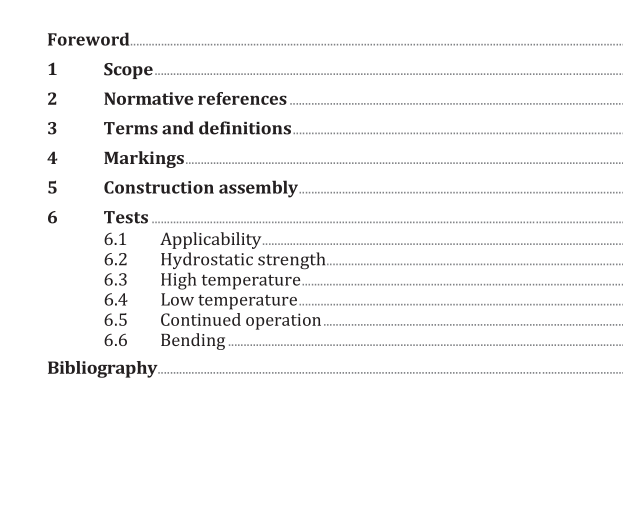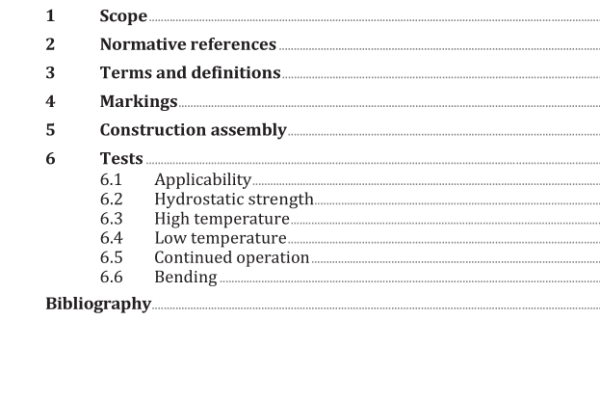ISO 20766-24:2022 pdf download – Road vehicles — Liquefied petroleum gas (LPG) fuel system components — Part 24: Gas tubes.
1 Scope This document specifies general requirements and definitions for the gas tube component of liquefied petroleum gas fuel, intended for use on the types of motor vehicles as defined in ISO 3833. It also provides general design principles and specifies requirements for instructions and marking. This document is applicable to vehicles (mono-fuel, bi-fuel or dual-fuel applications) using gaseous fuels in accordance with ISO 9162. It is not applicable to the following: a) fuel containers; b) stationary gas engines; c) container mounting hardware; d) electronic fuel management; e) refuelling receptacles. It is recognized that miscellaneous components not specifically addressed herein can be examined for compliance with the criteria of any applicable part of the ISO 20766 series, including testing to the appropriate functional tests. All references to pressure in this document are considered gauge pressures unless otherwise specified. This document applies to devices which have a service pressure in the range of 110 kPa (butane rich at 20 °C) and 840 kPa (propane at 20 °C), hereinafter referred to in this document. Other service pressures can be accommodated by adjusting the pressure by the appropriate factor (ratio). 2 Normative references The following documents are referred to in the text in such a way that some or all of their content constitutes requirements of this document. For dated references, only the edition cited applies. For undated references, the latest edition of the referenced document (including any amendments) applies. ISO 20766-1, Road vehicles — Liquefied petroleum gas (LPG) fuel systems components — Part 1: General requirements and definitions ISO 20766-2, Road vehicles — Liquefied petroleum gas (LPG) fuel systems components — Part 2: Performance and general test methods 3 Terms and definitions For the purposes of this document, the terms and definitions given in ISO 20766-1 and the following apply.
3.1 gas tube rigid fuel line made by metallic or non-metallic tubing which has been designed not to flex in normal operation and through which liquified petroleum gas flows 4 Markings Marking of the component shall provide sufficient information to allow the following to be traced: a) the manufacturer ’s or agent ’s name, trademark or symbol; b) the model designation (part number); c) the working pressure or-working pressure and temperature range; d) the serial number or date code; e) the direction of flow (when necessary for correct installation). The following additional markings are recommended: — the type of fuel; — the electrical ratings (if applicable); — the symbol of the certification agency; — the type approval number; — a reference to this document. NOTE This information can be provided by a suitable identification code on at least one part of the component when it consists of more than one part. In the event that a component cannot accommodate all marking requirements listed in this document, the manufacturer shall include missing marking information with the packaging of the component. 5 Construction assembly All gas tubes shall comply with the applicable provisions of ISO 20766-1 and ISO 20766-2, and with the tests specified in Clause 6 . The gas tubes shall be made of a corrosion-resistant material such as copper or stainless steel or they shall be protected with an external corrosion-resistant coating or non-metallic sleeve. Gas tubes shall be secured such that they are not subjected to vibration or stresses. At a fixing point, the gas tube shall be fitted with a protective material protecting against vibration or mechanical abrasion and galvanic corrosion. Gas tubes shall not be located at jacking points. At passages the gas tubes whether or not fitted with a protective sleeve, shall be fitted with protective material. The couplings shall be compatible with the gas tube.
ISO 20766-24:2022 pdf download – Road vehicles — Liquefied petroleum gas (LPG) fuel system components — Part 24: Gas tubes






